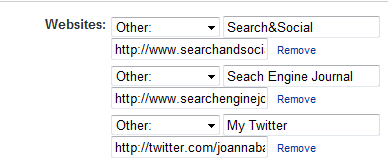Participating in social networks, blogs, forums and taking the time to keep your skills on the cutting edge via experimentation and even donating SEO pro bono wil not only boost your online reputation, but can also help you excel your career in search marketing.
Here are some ways to boost your SEO career profile.

1. Keep up with Social Networking
I have chosen to focus on two networks.Most SEO professionals are familiar with Twitter. Make sure the site is being used to its full potential by taking advantage with the best of Twitter for SEO purposes.
WeFollow.com-This is a Twitter Directory. I recommend including yourself if you have not already done so. The sign up process is short and simple. You will be asked to select up to five interests and this is where you will want to include topics such as SEO, social media, link building or anything you are involved in. Once you are added to the directory, those with similar interest will be able to find you easily and choose to follow you. This will improve your Twitter exposure to an SEO related audience.
TweetDeck-This is an excellent tool that allows people to keep up with Twitter at a glance. Download it and put an icon on your desktop. Click on the icon each morning and minimize it. Continue your work throughout the day and open the TweetDeck window as little or as much as you like.
TweetDeck basically condenses all of your Twitter information and makes it simple to select what you want to see and what you don’t. For example, I have chosen to have three columns in my TweetDeck including my friends, my mentions, and direct messages. A list appears below each resembling an easy to read chart. Multiple options are provided for each column such as clear all, mark as read, show most popular and a few others.
Other social networks like Facebook can be added to your personal TweetDeck if you choose. There are other tools that have been developed to make keeping up with multiple social networks easy such as helloTxt but I recommend TweetDeck. A successful Twitter profile is updated quite a bit and we know that can be considered tedious, however, it is necessary especially for any SEO professional. Having TweetDeck makes Tweeting and Retweeting convenient on a continuous basis.
Retweets- Traffic. Traffic. Traffic. When other Twitter users, especially other SEO affiliated Twitter users retweet your content, you will get a decent amount of traffic to your Twitter homepage. Retweets also make it possible to be bookmarked or voted via Digg, Sphinn, Reddit and more. Sharing is caring so remember to retweet others too!
Hashtags – The hashtag or # added to a tweet is an awesome way to create categories or group topics for tweets. This way, tweets regarding SEO can be grouped together. They are then easily found using the search.twitter.com feature.
Once you do, you are easily found. Try to google your name or someone you know on LInkedIn. I guarantee the LinkedIn profile affiliated with the name you search will pop up at the top of Google.
Post resume + Receive Recommendations = Professional Exposure.
If you don’t have anchor text on your LinkedIn profile, it is a good idea to add some. For example, instead of listing “My Company” on my Linked in profile, I have “Search&Social” as the anchor text attached to the URL I want. See Example Below.

- Go to Edit profile
- Go to Edit Website
- Scroll down to Other
- Add anchor text

2.Get SEO Certification
Even if you think you are sitting pretty solid when it comes to SEO, it never hurts to receive a little more education. An SEO certification can be beneficial because often times clients will feel they can enlist a little more trust in those who are certified. A certification makes an SEO professional appear more reliable and it puts someone with a certificate one step ahead of the competition. In addition to your appearance, it definitely helps expand your SEO educational background and knowledge. Market Motive is great opportunity with online courses from SEO industry professionals featuring videos and quizzes.3. Stay Informed
Keep up with readings and news. Try to stay on top of the most recent SEO updates. In addition to staying informed, it is a chance to tweet about hot topics and gain the interest of others. Even though I am familiar with a lot of topics floating around SEJ, I frequently find myself searching the Journal or referencing it for SEO news. I also turn to the popular SEObook and Search Engine RoundtableAgain, Twitter is helpful when attempting to hop on board the information train. Check your TweetDeck for SEO updates from those you are following.
4.Blog
Write about things you have experienced, seen, learned and accomplished. Write about what works and what doesn’t. Blog often. this is a chance for you to get noticed. Keep in mind commenting is just as important blogging.5. Keep the same Avatar for everything
Keep your image the same. A friendly face encourages people to click on your tweets, blogs and all other content. Face recognition can go a long way in the SEO world.6.Do Non-Profit Work
In addition to simply helping a good cause, charity work helps others see what you are capable of. I suggest picking a local non-profit and taking it upon yourself to see what you can do for them. Create a website if one doesn’t exist, help with their SEO efforts and get involved. Don’t be hesitant or shy to lend a hand. You will be surprised at the reaction you get. Non-profits are excited to have an interested party who is willing to help them.Not only will this help present your talents to the public but it is also a great way to network. The organization you choose may have a board of directors you could join and once you attend meetings and socialize, your success and talents will be recognized by the people on the board and others throughout the organization. Participating in SEO for just one non-profit can get you pretty far. You will be amazed at how people you don’t know will eventually be coming to you asking for your services because the word on the street is you did an amazing job with “X” charity.
7. Create a Portfolio
Create a digital showcase to display your collection. Include an About Me section. For SEO purposes, this section is a good idea because you can be found based on the information inserted.Place the criteria within a meta description tag to give relevant information to those who are scanning results which encourages more visits.
In the About me section include:
- Schools attended
- Fields of expertise
- Current employment